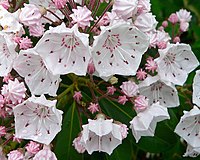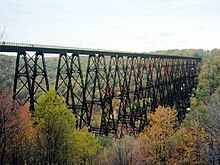Portal:Pennsylvania
The Pennsylvania Portal Pennsylvania (/ˌpɛnsɪlˈveɪniə/ , lit. 'Penn's forest country'), officially the Commonwealth of Pennsylvania (Pennsylvania Dutch: Pennsylvanie), is a state spanning the Mid-Atlantic, Northeastern, Appalachian, and Great Lakes regions of the United States. Pennsylvania borders Delaware to its southeast, Maryland to its south, West Virginia to its southwest, Ohio and the Ohio River to its west, Lake Erie and New York to its north, the Delaware River and New Jersey to its east, and the Canadian province of Ontario to its northwest. Pennsylvania was founded in 1681 through a royal land grant to William Penn, the son of the state's namesake. Prior to that, between 1638 and 1655, a southeast portion of the state was part of New Sweden, a Swedish Empire colony. Established as a haven for religious and political tolerance, the colonial-era Province of Pennsylvania was known for its relatively peaceful relations with native tribes, innovative government system, and religious pluralism. Pennsylvania played a vital and historic role in the American Revolution and the ultimately successful quest for independence from the British Empire, hosting the First and Second Continental Congress leading to the adoption of the Declaration of Independence. On December 12, 1787, Pennsylvania became the second state to ratify the U.S. Constitution. The bloodiest battle of the American Civil War, at Gettysburg over three days in July 1863, proved the war's turning point, leading to the Union's preservation. Throughout the late 19th and 20th centuries, the state's manufacturing-based economy contributed to the development of much of the nation's early infrastructure, including key bridges, skyscrapers, and military hardware used in U.S.-led victories in World War I, World War II, and the Cold War. Pennsylvania's geography is highly diverse. The Appalachian Mountains run through the center of the state; the Allegheny and Pocono mountains span much of Northeastern Pennsylvania; close to 60% of the state is forested. While it has only 140 miles (225 km) of waterfront along Lake Erie and the Delaware River, Pennsylvania has the most navigable rivers of any state in the nation, including the Allegheny, Delaware, Genesee, Ohio, Schuylkill, Susquehanna, and others. (Full article...) This is a Featured article, which represents some of the best content on English Wikipedia..
Ricketts Glen State Park is a Pennsylvania state park on 13,193 acres (5,280 ha) in Columbia, Luzerne, and Sullivan counties in Pennsylvania in the United States. Ricketts Glen is a National Natural Landmark known for its old-growth forest and 24 named waterfalls along Kitchen Creek, which flows down the Allegheny Front escarpment from the Allegheny Plateau to the Ridge-and-Valley Appalachians. The park is near the borough of Benton on Pennsylvania Route 118 and Pennsylvania Route 487, and is in five townships: Sugarloaf in Columbia County, Fairmount and Ross in Luzerne County, and Colley and Davidson in Sullivan County. Ricketts Glen's land was once home to Native Americans. From 1822 to 1827, a turnpike was built along the course of PA 487 in what is now the park, where two squatters harvested cherry trees to make bed frames from about 1830 to 1860. The park's waterfalls were one of the main attractions for a hotel from 1873 to 1903; the park is named for the hotel's proprietor, R. Bruce Ricketts, who built the trail along the waterfalls. By the 1890s Ricketts owned or controlled over 80,000 acres (320 km2; 120 sq mi) and made his fortune clearcutting almost all of that land, including much of what is now the park; however he preserved about 2,000 acres (810 ha) of virgin forest in the creek's three glens. The sawmill was at the village of Ricketts, which was mostly north of the park. After his death in 1918, Ricketts' heirs began selling land to the state for Pennsylvania State Game Lands. (Full article...)Selected geography article -The Kinzua Bridge or the Kinzua Viaduct (/ˈkɪnzuː/, /-zuːə/) was a railroad trestle that spanned Kinzua Creek in McKean County in the U.S. state of Pennsylvania. The bridge was 301 feet (92 m) tall and 2,052 feet (625 m) long. Most of its structure collapsed during a tornado in July 2003. Billed as the "Eighth Wonder of the World", the wrought iron original 1882 structure held the record for the tallest railroad bridge in the world for two years. In 1900, the bridge was dismantled and simultaneously rebuilt out of steel to allow it to accommodate heavier trains. It stayed in commercial service until 1959, when it was sold to a salvage company. In 1963 the Commonwealth of Pennsylvania purchased the bridge as the centerpiece of a state park. (Full article...)Selected image -Did you know -
Related portalsWikiprojectsThis is a Good article, an article that meets a core set of high editorial standards.
 Selected article -William Henry Cosby Jr. (/ˈkɒzbi/ KOZ-bee; born July 12, 1937) is an American former comedian, actor, spokesman, and media personality. Cosby gained a reputation as "America's Dad" for his portrayal of Cliff Huxtable on The Cosby Show (1984–1992). He has received numerous awards and honorary degrees throughout his career, though many of them were revoked following sexual assault allegations made against him in 2014. Cosby began his career as a stand-up comic at the hungry i nightclub in San Francisco during the 1960s. Throughout the decade, he released several standup comedy records which consecutively earned him the Grammy Award for Best Comedy Album from 1965 to 1970. He also had a starring role in the television secret-agent show I Spy (1965–1968) opposite Robert Culp. Cosby made history when he won the Primetime Emmy Award for Outstanding Lead Actor in a Drama Series in 1966, making him the first African American to earn an Emmy Award for acting. His acting career continued as he starred in the sitcom The Bill Cosby Show, which ran for two seasons from 1969 to 1971. (Full article...)Pennsylvania news
CategoriesState factsState Facts
State symbols
Pennsylvania topicsGeneral imagesThe following are images from various Pennsylvania-related articles on Wikipedia.
Associated WikimediaThe following Wikimedia Foundation sister projects provide more on this subject:
Discover Wikipedia using portals |


































































